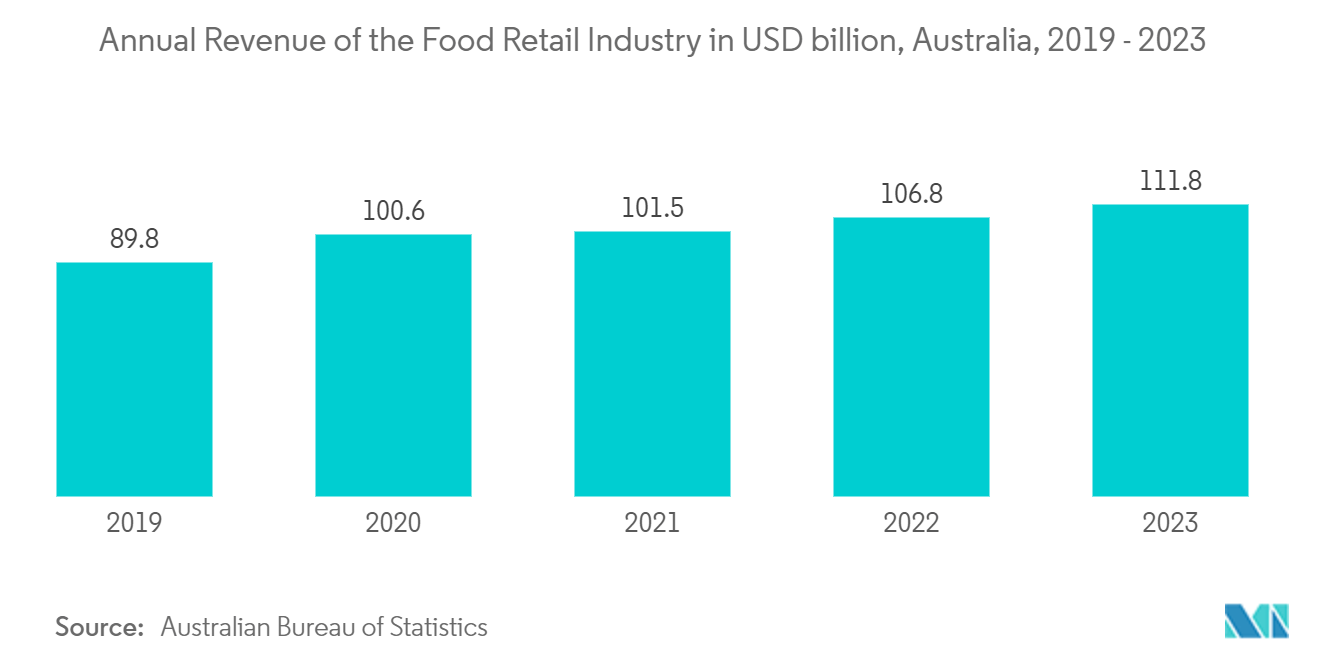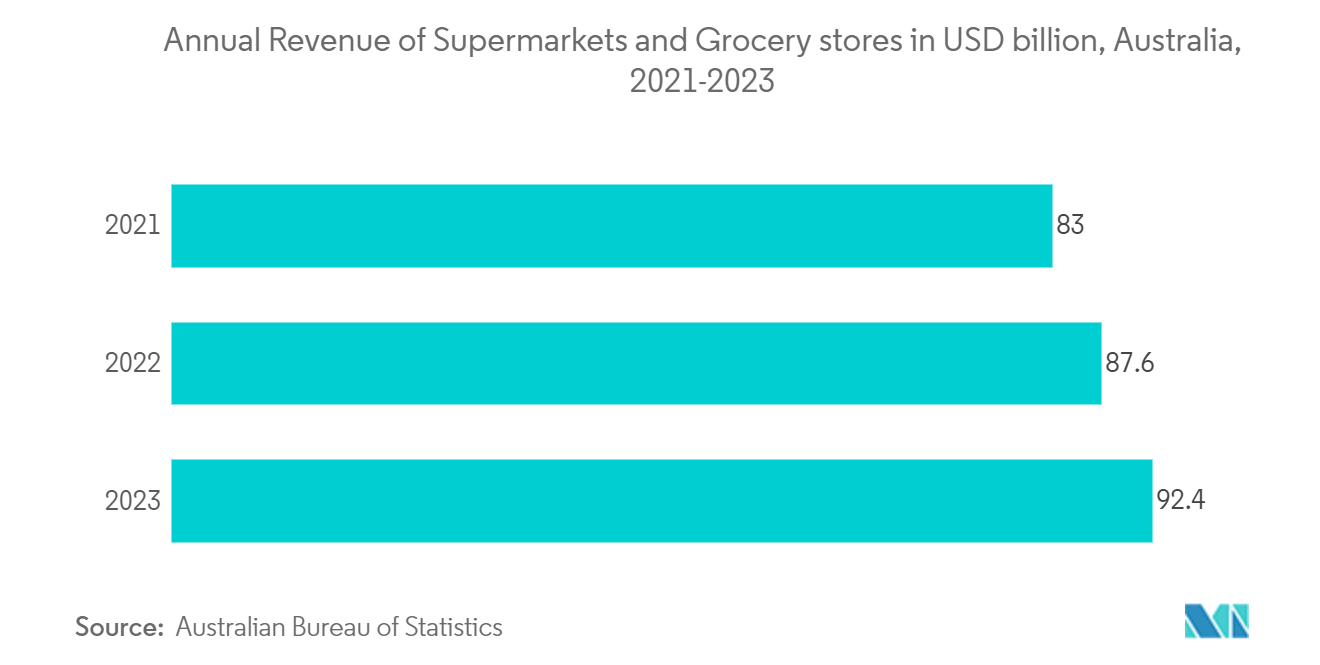Market Trends of Australia And New Zealand Plastic Packaging Film Industry
Food Segment to Hold Significant Market Share
- As consumer lifestyles evolve to accommodate busier schedules, the demand for convenient meal options, like frozen foods, has surged. Plastic film packaging is pivotal in this narrative, providing easy-to-open formats that align with the need for quick meal preparation. Additional features, such as resealable closures and portion-sized packs, further elevate the convenience factor for consumers. The growing frozen food market has consequently heightened the demand for plastic film packaging.
- Australia's urban customers increasingly favor convenient packaging, spurring demand for user-friendly and lightweight solutions. In response, vendors are pivoting their designs to stay ahead in the expanding organized retail landscape, adapting to evolving consumer preferences. This shift is driven by the need for packaging that enhances the consumer experience and aligns with sustainability goals. Embracing lighter materials, notably plastic film pouches, meets these demands and offers substantial energy-saving advantages. Additionally, these materials reduce transportation costs and environmental impact, making them a preferred choice for manufacturers and consumers.
- In 2023, Australia's food retail industry generated an annual revenue exceeding USD 111.8 billion, up from USD 101.5 billion in 2021, showcasing consistent year-on-year growth. This upward trajectory in food retail has underscored the demand for plastic film packaging, essential for preserving food quality, extending shelf life, and enhancing product presentation. The increased revenue highlights the sector's resilience and adaptability in meeting consumer needs and preferences.
- Food manufacturers increasingly demand lightweight, protective, visually appealing, and high-barrier packaging. This trend is expected to drive sales in the plastic film packaging sector. The multi-sensory experience associated with plastic film packaging entices purchases and bolsters the market's growth trajectory. Additionally, the versatility and cost-effectiveness of plastic film packaging make it a preferred choice among manufacturers, further enhancing its market appeal.
- Despite Australia's active efforts to reduce plastic packaging, its benefits compared to alternatives have allowed manufacturers to continue their production. The country has established ambitious 2025 National Packaging Targets, charting a sustainable path for packaging management. The Australian food industry and the government are behind these targets, pushing for a greener packaging approach. These comprehensive targets cover all packaging activities within the nation, signaling a substantial move toward a more sustainable future.

Polyethylene Segment Expected to Hold Significant Share in the Market
- Polyethylene is primarily used in packaging, including plastic bags, films, and geomembranes. This thermoplastic resin is lightweight and partially crystalline, boasting high chemical resistance, low moisture absorption, and sound-insulating properties. Within the polyethylene family, LDPE (low-density polyethylene) stands out for its flexibility, making it a preferred choice for film packaging and electrical insulation. LDPE is extensively utilized in various applications, ranging from packaging films, trash, and grocery bags to agricultural mulch, wire, and cable insulation. Its lower crystallinity than HDPE results in a softer, more flexible texture, albeit with a slightly reduced barrier capability.
- LDPE is widely used in flexible packaging and is prized for its affordability and chemical and oil resistance. Unlike HDPE, LDPE has a slightly cloudy appearance but offers better clarity. With a lower melting point, LDPE might not fare well in applications requiring high heat stability, but it is a boon in scenarios where lower melting points are preferred. LLDPE, a prevalent choice in the packaging sector, also stands out for its lower density and the inclusion of comonomers, which introduce branch-like structures on its primary chain, thereby reducing crystallinity. This alteration leads to a hazy appearance and a more pliable texture. Notably, when matched for density and thickness, LLDPE surpasses LDPE in impact strength, tensile strength, puncture resistance, and elongation.
- Consumers' growing preference for convenient shopping experiences is evident in the uptick in supermarket and grocery store sales. With shoppers turning to these outlets for their daily needs, the demand for plastic film packaging is surging. This packaging is favored for its user-friendly, portable, and storage-friendly nature. Additionally, polyethylene film offers benefits such as extended shelf life for perishable goods, reduced product damage during transportation, and enhanced visual appeal, further driving its adoption in the retail sector.
- Two major players, the Woolworths Group and the Coles Group, dominate Australia's supermarket and grocery retail market. The states of New South Wales and Victoria, being the most populous, host the highest number of supermarkets in the country. Alongside these giants, Australia boasts various grocery outlets, including the German chain Aldi and the independently owned IGA stores. The annual revenue of Australia's supermarket and grocery retail sector has seen consistent growth. In 2023, the industry's revenue surpassed USD 92.4 billion, up from USD 83 billion in 2021. This upward trajectory in Australia's supermarket sector not only underscores rising demand but also hints at opportunities in the plastic film market.


